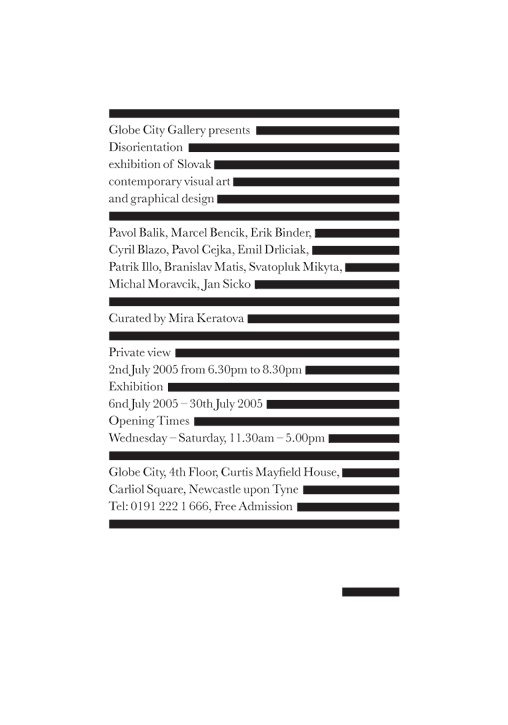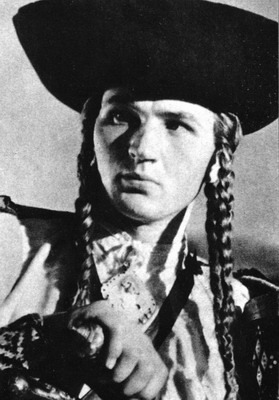Disorientation – exhibition of Slovak contemporary visual art and graphical desi

Participating artists: Pavol Balik, Marcel Bencik, Erik Binder, Cyril Blazo, Pavol Cejka, Emil Drliciak, Patrik Illo Branislav Matis, Svatopluk Mikyta, Michal Moravcik, Jan Sicko, Exhibition: 2nd July 2005 – 30th July 2005
Opening Times: Wednesday – Saturday, 11.30am – 5.00pm
Globe City, 4th Floor, Curtis Mayfield House, Carliol Square, Tel: 0191 222 1 666, Free Admission. Curated by Mira KeratovaAn exchange programme funded by Arts Council England North East, Visiting Arts and Slovakian Ministry of Culture. Globe City Gallery in Newcastle presents the work of eleven internationally acclaimed artists and graphic designers from Slovakia in an exciting artists exchange.
Visitors to Globe City will have the opportunity to view some of the top names of Slovakian artists who have exhibited in art biennales around the world and have won prestigious awards, equivalent to the Turner Prize here in the UK. The Slovaks work selected by curator, Mira Keratova, presents an attractive mix of ‘socialist-reality’ and progressive contemporary graphic design and expresses the fundamental transformations undergone by this post-Socialist State and newcomer to the EU (2004).

This ambitious project aims to unveil the exciting world of Slovakian contemporary visual arts and suggests that there are even more reasons to visit Slovakia. On the other hand, the second part of this exchange, which will be taking place in November 2005 in collaboration with Hit Gallery and Billboart Gallery Europe in Bratislava, aspires to introduce a profile of UK artists who have between them achieved regional national and international status. Artists from Uk to Slovakia:
Claire Davies, Richard Phipps, Andrew Hardy, Lynne Marsh and Francis Gomila.
Zuzana Albertsen coordinator of the project comments: “The project synopsis is mainly based on a physical & mental disorientation structure. Being a migrant myself (Zuzana Albertsen) and living on the ’outside’, while moving between two countries made me aware of two diverse art worlds. As a project coordinator and curator, I didn’t want to apply the usual East-West schisms or clichés, but purely allowing artists to interact, culturally mix/share their ideas and develop new contacts for the future collaboration. We believe that allowing artists to react and bring their vision under these circumstances will bring short-term impact and long-term collaboration in terms of new work production and interactive share. The whole project should act as the movement of such activities that have been arising as a response to the socio-political situation with its individual perception.”
Additional info:
Interdisciplinary project Disorientation is based on experimental presentation of progressive Slovak contemporary graphic design and contemporary art of the youngest generation of Slovak authors. The project tackles the topic of disorientation in the context of the so-called infotainment and its impact on the character of the contemporary visual culture. This is embodied in the site-specific project realised by the selected designers who transform the gallery spaces into “disorienting system” similar to the models of information architecture and hypermedia systems. The second parallel of the project are exclusively selected works of contemporary Slovak artists that evaluate the visual qualities of the socialist aesthetics.
The project Disorientation erases the already blurred line between the traditionally defined free and “utility” art; these two differ in their communication framework; free art disperses the communication stream whereas “utility” art concentrates it. The ambition of the project is to explore new interpretation channels of the contemporary culture and to define gallery in a new way as an active subject in the equation art vs. information/entertainment.
The project is based on intense communication of artists and graphical designers, while the former create design originating from the aesthetics of the so-called socialistic period, either through manipulation or direct use of ready-made products. On the contrary, graphical designers prepare artworks addressing the disorientation theme; their presentation will follow the example of hypermedia systems and/or analogous semantic networks where disorientation is a significant problem (finally it is also the first difficulty through which the graphical designer has to get in his/her work). The aim of the whole project is to present artworks (as very intricate interpretive systems) in fact acting as factors of disorientation. Thus will the project generate a quasi disorienting environment and emphasise its role as an important phenomenon. As if a model of information architecture was invented, where the viewer, similarly to the user of very rich environment of hypermedia systems – due to the interconnections between the information /visual signs, can be disorientated, as though navigating the hyperbase.
The disorientation structure of the exhibition will be supplemented with interventions (communicating with the whole system) of other participating artists installing the the so-called Forgotten Objects (refering to the modern term of “l´object trouvé”). This “eclectic show” will thus be aiming to encourage and explore experimental approaches to the presentation of contemporary visual art, particularly approaches that re-interpret art or artwork itself in actual surrounding. Forgotten objects reflect the retro socialist aesthetics, making use of the then available ready-mades and thereby re-interpret the socialist pop (or rather prolet) culture. This connecting line is compatible with the topic of disorientation also in the context of the unclear and not very self-conscious cultural identity, typical for Slovakia as well as other post-communist countries that blindly adapt themselves to imported cultural, social and political patterns (USSR then, EU now). The expedient to the overall network of connections, installations and other works will be a cd catalogue giving a thorough account of the project preparation.



